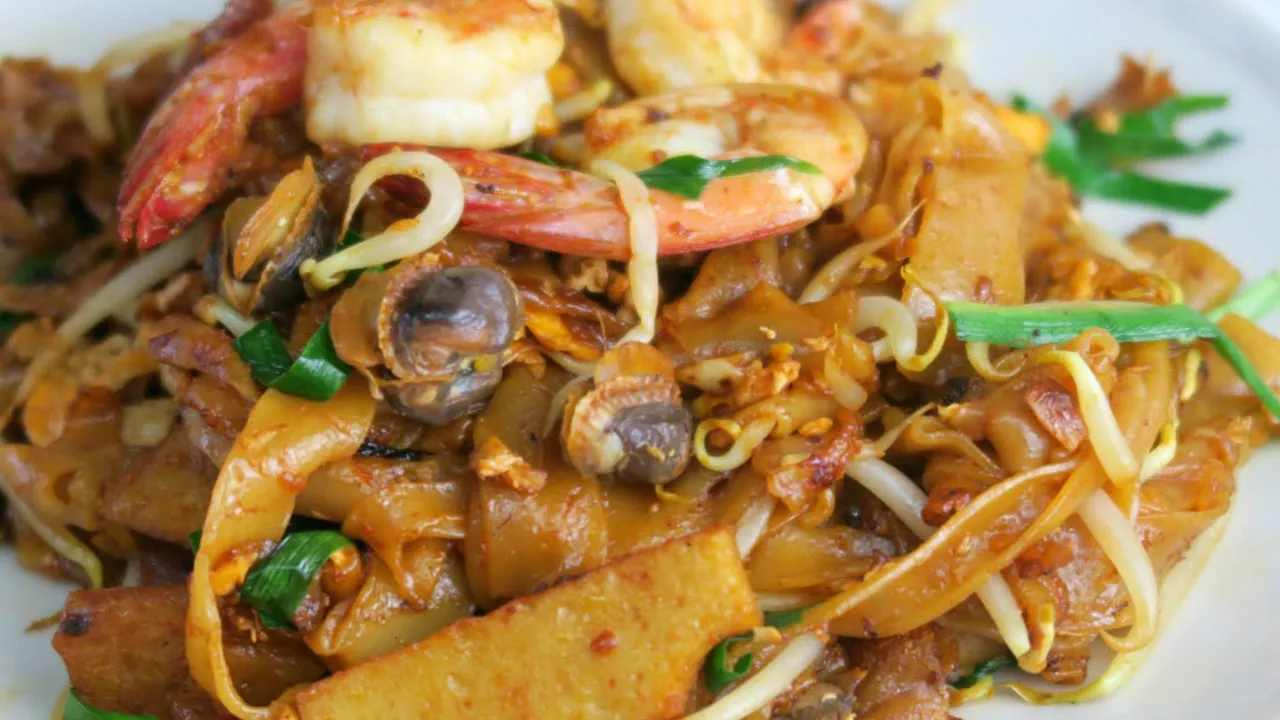Char Kway Teow: Stir-Fried Noodles with Seafood

What is Char Kway Teow A Malaysian Culinary Gem
Okay, let's talk Char Kway Teow (CKT). If you're even remotely interested in Malaysian food, you've definitely heard of this dish. It's basically stir-fried rice noodles, and it's a flavor explosion. It's smoky, savory, a little sweet, and sometimes spicy – all at the same time. Think of it as a noodle dish that's got personality. It's not just food; it's an experience. You can find it everywhere from hawker stalls to fancy restaurants. The key is the wok hei, that smoky char that comes from a super-hot wok.
Char Kway Teow The Ingredients That Make It Sing
So, what goes into this masterpiece? The main player is, of course, the flat rice noodles (kway teow). Then you've got prawns, cockles (blood cockles – don't be scared!), Chinese sausage (lap cheong), bean sprouts, chives, and eggs. Sometimes you'll find fish cake or even crab meat thrown in, depending on where you are and how fancy the cook wants to get. The sauce is a mix of soy sauce, dark soy sauce (for that color and sweetness), oyster sauce, and chili paste. Some cooks add a little bit of shrimp paste (belacan) for an extra layer of umami. The quality of the ingredients really matters here. Fresh prawns, juicy cockles, and good quality Chinese sausage make all the difference.
The Wok Hei Secret Char Kway Teow Stir Frying Techniques
The magic of CKT isn't just in the ingredients, it's in the cooking. It's all about the wok hei. This is the smoky flavor that comes from stir-frying over very high heat in a well-seasoned wok. The cook needs to be fast and skillful, tossing the noodles and ingredients constantly to prevent them from burning and to ensure they're evenly coated in the sauce. A good CKT cook can make a batch in just a few minutes. The high heat caramelizes the sugars in the sauce and gives the noodles that characteristic smoky flavor. It's a real art form.
Best Char Kway Teow in Malaysia Where to Find Culinary Gold
Alright, so where do you find the best CKT in Malaysia? That's a tough question, because everyone has their favorite spot. But here are a few places that are consistently rated highly:
- Penang: This is where CKT is said to have originated, so you'll find some legendary stalls here. Look for stalls in Georgetown and Gurney Drive.
- Kuala Lumpur: There are plenty of great CKT places in KL, especially in the hawker centers like Jalan Alor and Imbi Market.
- Ipoh: Ipoh is known for its delicious food, and its CKT is no exception. Check out the local coffee shops and hawker stalls.
Don't be afraid to try different places and see what you like best. Ask the locals for recommendations – they'll usually point you in the right direction. The best way to find your favorite CKT is to eat your way through Malaysia!
Char Kway Teow Variations Regional Twists and Personal Preferences
CKT isn't a rigid dish; there are plenty of variations depending on where you are and who's cooking it. In Penang, they often use duck eggs, which give the noodles a richer flavor and a slightly different texture. Some places add mantis prawns, which are a real delicacy. In other regions, you might find it served with different types of seafood, like squid or crab. Some cooks like to add a lot of chili, while others keep it mild. It really comes down to personal preference. Experiment and find the variations that you enjoy the most.
Char Kway Teow A Guide to Cockles Freshness and Safety
Okay, let's talk about cockles. Some people are a little hesitant to try them, but they're a key ingredient in CKT. They add a briny, slightly metallic flavor that complements the other ingredients perfectly. The key is to make sure they're fresh and cooked properly. Look for cockles that are plump and have a clean, briny smell. They should be cooked until they just open, and not overcooked, which will make them tough and rubbery. If you're worried about food safety, make sure you're buying your CKT from a reputable vendor who uses fresh ingredients and follows proper hygiene practices. Don't be afraid to ask questions!
Char Kway Teow Chinese Sausage Lap Cheong Quality Matters
Another key ingredient is Chinese sausage, or lap cheong. This is a dried, cured sausage that's sweet and savory. It adds a lot of flavor to the CKT. The quality of the lap cheong really matters. Look for sausages that are firm, have a good color, and smell fragrant. Avoid sausages that are pale or have a rancid smell. Good quality lap cheong will be slightly sweet and have a good balance of fat and lean meat. It should be cooked until it's slightly crispy on the edges.
Making Char Kway Teow at Home A Recipe and Tips
Want to try making CKT at home? It's not as hard as you might think! Here's a basic recipe:
- Ingredients: Flat rice noodles, prawns, cockles, Chinese sausage, bean sprouts, chives, eggs, soy sauce, dark soy sauce, oyster sauce, chili paste, garlic.
- Instructions: Heat a wok over high heat. Add garlic and stir-fry until fragrant. Add prawns and Chinese sausage and stir-fry until cooked. Add cockles and stir-fry until they just open. Add noodles, bean sprouts, and chives and stir-fry until heated through. Add soy sauce, dark soy sauce, oyster sauce, and chili paste and stir-fry until the noodles are evenly coated. Crack in an egg and stir-fry until the egg is cooked. Serve immediately.
The key to making good CKT at home is to use a very hot wok and to stir-fry the ingredients quickly. Don't overcrowd the wok, or the noodles will steam instead of stir-fry. You can adjust the amount of chili paste to your liking. Don't be afraid to experiment!
Char Kway Teow Health Considerations Calories and Nutritional Value
Let's be honest, CKT isn't exactly a health food. It's high in calories and fat. But it's also delicious and satisfying! If you're watching your weight, you can try ordering a smaller portion or asking for less oil. You can also add more vegetables to make it a bit healthier. It's okay to indulge in CKT every now and then, just don't make it a daily habit. Everything in moderation!
Char Kway Teow Beyond the Plate Cultural Significance and History
CKT is more than just a dish; it's a part of Malaysian culture. It's a dish that's enjoyed by people of all ages and backgrounds. It's often eaten at hawker centers and coffee shops, which are important social gathering places. CKT is a symbol of Malaysian street food culture and a reminder of the country's rich culinary heritage. It's a dish that brings people together.
Char Kway Teow Pairing Perfection Drinks to Complement Your Meal
What goes well with CKT? A cold glass of Chinese tea is a classic choice. The tea helps to cut through the richness of the noodles and cleanse the palate. Other good options include lime juice, coconut water, or even a cold beer. Avoid drinks that are too sweet or overpowering, as they can clash with the flavors of the CKT. Keep it simple and refreshing.
Char Kway Teow Recommended Chili Pastes for that Extra Kick
The chili paste is a crucial element in CKT, adding heat and depth of flavor. Here are a few recommended chili pastes to enhance your CKT experience:
- Homemade Chili Paste: The best option! You can control the ingredients and spice level. Typically includes dried chilies, garlic, shallots, and shrimp paste.
- Commercial Chili Paste (Sambal Oelek): A readily available option that provides a good level of heat. Look for brands with minimal additives.
- Malaysian Chili Paste (Sambal Belacan): Adds a unique umami flavor due to the fermented shrimp paste. Use sparingly as it can be quite pungent.
When choosing a chili paste, consider your spice tolerance and flavor preferences. Start with a small amount and add more to taste.
Char Kway Teow Soy Sauce Selection The Umami Factor
Soy sauce is another key ingredient that contributes to the savory flavor of CKT. Here are a few recommendations:
- Light Soy Sauce: Provides a salty base and enhances the other flavors.
- Dark Soy Sauce: Adds color, sweetness, and a richer flavor. Use sparingly to avoid overpowering the dish.
- Premium Soy Sauce: Often aged and has a more complex flavor profile.
Look for soy sauces with a high sodium content and a rich, umami flavor. Experiment with different brands to find your favorite.
Char Kway Teow Wok Recommendations and Stir Frying Tools
To achieve that authentic wok hei flavor, a good wok is essential. Here are some recommendations:
- Carbon Steel Wok: The traditional choice for stir-frying. It heats up quickly and evenly and develops a natural non-stick surface over time.
- Cast Iron Wok: Retains heat well but can be heavier than carbon steel.
Other essential tools include a wok spatula, a ladle, and a long pair of chopsticks. A powerful stove with a high BTU output is also crucial for achieving the desired wok hei.
Char Kway Teow Pricing Guide A Culinary Adventure for Every Budget
The price of CKT can vary depending on the location, ingredients, and portion size. Here's a general pricing guide:
- Hawker Stalls: RM 6 - RM 12 (USD 1.50 - USD 3) - The most affordable option.
- Coffee Shops: RM 8 - RM 15 (USD 2 - USD 3.75) - Slightly more expensive than hawker stalls.
- Restaurants: RM 15 - RM 30 (USD 3.75 - USD 7.50) - The most expensive option, but often features higher quality ingredients and a more refined presentation.
Prices may be higher in tourist areas or upscale restaurants. Be sure to check the menu before ordering.
Char Kway Teow Storage Tips How to Keep Leftovers Delicious
While CKT is best enjoyed fresh, leftovers can be stored in the refrigerator for up to 24 hours. To reheat, stir-fry in a wok or microwave until heated through. The noodles may become slightly softer, but the flavor should still be good. Avoid freezing CKT as the noodles will become mushy.
:max_bytes(150000):strip_icc()/277019-baked-pork-chops-with-cream-of-mushroom-soup-DDMFS-beauty-4x3-BG-7505-5762b731cf30447d9cbbbbbf387beafa.jpg)






